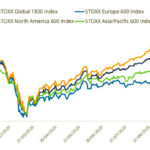Euro Dollars are a fascinating and crucial part of the global financial system. Despite the name, they have nothing to do with the euro currency or the European Union directly. Instead, the term “euro dollar” refers to U.S. dollar-denominated deposits held in banks outside of the United States, or in overseas branches of American banks. These deposits operate largely outside the regulatory reach of the U.S. Federal Reserve (Fed), setting them apart from domestic U.S. dollar accounts.
/dollarbills-5c5a055cc9e77c00017a6972.jpg)
Understanding the Mechanics of Euro Dollars
The core appeal of euro dollars lies in their unique regulatory environment. Because these dollar deposits reside outside the U.S., they are not subject to the same regulations imposed by the Federal Reserve on domestic banks. A key example is the reserve requirement, which mandates that banks hold a certain percentage of deposits in reserve. The absence of this and other regulations in the euro dollar market can translate to potentially higher interest rates for depositors. This is because banks operating with euro dollars have lower overhead costs due to reduced regulatory burdens and can pass some of these savings to depositors in the form of increased interest.
However, this higher interest rate potential comes with a trade-off. The reduced regulatory oversight also implies increased risk. Euro dollar deposits lack the protections afforded to domestic U.S. accounts, such as deposit insurance from the Federal Deposit Insurance Corporation (FDIC). This means that in the event of a bank failure, euro dollar depositors might face greater losses compared to those holding funds in FDIC-insured U.S. banks.
The geographical location of euro dollar deposits also introduces another layer of risk – political and economic instability in the host country. While many euro dollar accounts are held in branches located in stable regions like Europe, the Bahamas, and the Cayman Islands, geopolitical events could still impact these deposits.
Euro Dollars as a Major Capital Market Force
The euro dollar market is not just a niche financial corner; it’s a significant global capital market. It serves as a vital source of short-term funding for corporations and financial institutions worldwide. Companies often turn to euro dollar loans because borrowing costs can be more competitive than in other markets.
Furthermore, businesses with international operations utilize euro dollars for hedging against foreign exchange risks. By borrowing or depositing in euro dollars, companies can manage their exposure to currency fluctuations and stabilize their international financial transactions.
The liquidity of the euro dollar market is substantial. Transactions are typically large, often involving deposits of $100,000 to millions of dollars, primarily conducted by professional financial institutions. A significant portion of the market operates on an overnight basis, meaning loans mature the next business day. The sheer volume of these transactions is staggering. For instance, the Federal Reserve Bank of New York has reported average daily volumes of overnight euro dollar transactions reaching $150 billion.
A Practical Example of Euro Dollar Usage
Imagine a U.S.-based corporation with surplus cash that isn’t immediately needed for domestic operations. Instead of keeping this cash in a U.S. bank at potentially lower interest rates, the company could deposit it in a bank located outside the U.S. This deposit, still denominated in U.S. dollars, becomes a euro dollar deposit. By doing so, the company aims to earn a higher return on their cash holdings due to the potentially more favorable interest rates offered in the euro dollar market.
Many major American banks operate offshore branches, particularly in the Caribbean, specifically to handle euro dollar deposits. European banks are also key players in this market. Interestingly, even when transactions involve Caribbean branches of U.S. banks, the actual trading often happens in U.S. dealing rooms, and the funds are utilized to finance both domestic and international business activities.
The Historical Roots of the Euro Dollar Market
The euro dollar market’s origins trace back to the post-World War II era. The Marshall Plan, a U.S.-led initiative to rebuild Europe, injected significant amounts of U.S. dollars into the European economy. This influx of dollars created a pool of USD outside the U.S., leading to the development of a separate market for these funds, one characterized by less stringent regulation.
This less regulated environment, free from the Federal Reserve’s reserve requirements and FDIC insurance, became a defining feature of the euro dollar market, contributing to the higher interest rates associated with these deposits.
Euro Dollars: Investment Accessibility and Risk Assessment
Can individuals invest in euro dollars? Yes, but direct investment is typically limited to institutional investors and large corporations due to the substantial deposit amounts usually involved, often starting in the millions. However, individual investors can gain indirect exposure through mutual funds that invest in euro dollar futures. Setting up a dollar-denominated account in a foreign bank or purchasing certificates of deposit abroad is also possible, although it comes with the complexities of international banking and regulations of the host country.
In terms of risk, euro dollars inherently carry more risk than FDIC-insured domestic U.S. deposits. The absence of reserve requirements and FDIC protection means that euro dollar deposits are not backed by the U.S. government in the same way as domestic accounts. This necessitates a careful risk assessment for anyone engaging with the euro dollar market.
In Conclusion: Navigating the Euro Dollar Landscape
Despite its name suggesting European currency, the term “euro dollar” simply denotes U.S. dollar deposits held in banks outside the United States. These deposits offer the allure of potentially higher interest rates compared to domestic banks, driven by a less regulated environment. However, this advantage is balanced by increased risks, including reduced regulatory protection and potential political or economic risks associated with the deposit’s location. Understanding these dynamics is crucial for anyone involved in international finance and for comprehending the broader workings of the global capital markets.


